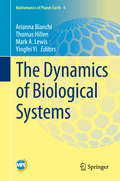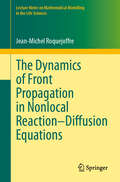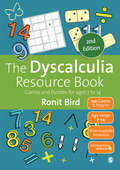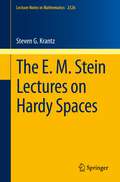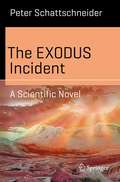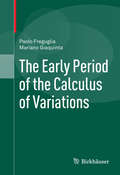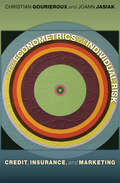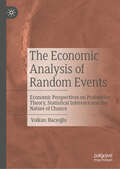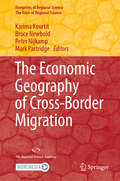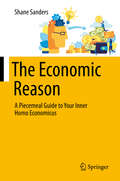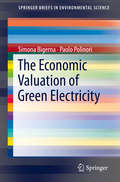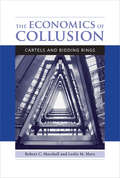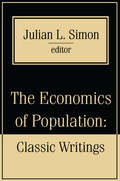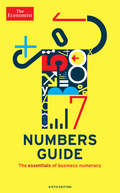- Table View
- List View
The Dynamics of Biological Systems (Mathematics of Planet Earth #4)
by Mark A. Lewis Thomas Hillen Yingfei Yi Arianna BianchiThe book presents nine mini-courses from a summer school, Dynamics of Biological Systems, held at the University of Alberta in 2016, as part of the prestigious seminar series: Séminaire de Mathématiques Supérieures (SMS). It includes new and significant contributions in the field of Dynamical Systems and their applications in Biology, Ecology, and Medicine. The chapters of this book cover a wide range of mathematical methods and biological applications. They - explain the process of mathematical modelling of biological systems with many examples, - introduce advanced methods from dynamical systems theory, - present many examples of the use of mathematical modelling to gain biological insight- discuss innovative methods for the analysis of biological processes,- contain extensive lists of references, which allow interested readers to continue the research on their own. Integrating the theory of dynamical systems with biological modelling, the book will appeal to researchers and graduate students in Applied Mathematics and Life Sciences.
The Dynamics of Discrete Populations and Series of Events
by Keith Iain Hopcraft Eric Jakeman Kevin D. RidleyDiscrete phenomena are an important aspect of various complex systems, acting both as underlying driving mechanisms and as manifestations of diverse behaviours. However, the characterisation of these discrete phenomena requires models that go beyond those featured in existing books. Largely concerned with mathematical models used to describe time-v
The Dynamics of Front Propagation in Nonlocal Reaction–Diffusion Equations (Lecture Notes on Mathematical Modelling in the Life Sciences)
by Jean-Michel RoquejoffreThe book provides a self-contained and complete description of the long time evolution of the solutions to a class of one-dimensional reaction–diffusion equations, in which the diffusion is given by an integral operator. The underlying motivation is the mathematical analysis of models for biological invasions. The model under study, while simple looking, is of current use in real-life situations. Interestingly, it arises in totally different contexts, such as the study of branching random walks in probability theory. While the model has attracted a lot of attention, and while many partial results about the time-asymptotic behaviour of its solutions have been proved over the last decades, some basic questions on the sharp asymptotics have remained unanswered. One ambition of this monograph is to close these gaps. In some of the situations that we envisage, the level sets organise themselves into an invasion front that is asymptotically linear in time, up to a correction that converges exponentially in time to a constant. In other situations that constitute the main and newest part of the work, the correction is asymptotically logarithmic in time. Despite these apparently different behaviours, there is an underlying common way of thinking that is underlined. At the end of each chapter, a long set of problems is proposed, many of them rather elaborate and suitable for master's projects or even the first question in a PhD thesis. Open questions are also discussed. The ideas presented in the book apply to more elaborate systems modelling biological invasions or the spatial propagation of epidemics. The models themselves may be multidimensional, but they all have in common a mechanism imposing the propagation in a given direction; examples are presented in the problems that conclude each chapter. These ideas should also be useful in the treatment of further models that we are not able to envisage for the time being. The book is suitable for graduate or PhD students as well as researchers.
The Dyscalculia Resource Book: Games and Puzzles for ages 7 to 14
by Ronit BirdWritten by a teacher for teachers, the second edition of Ronit Bird’s The Dyscalculia Resource Book now comes with 120 games and puzzles and a brand new section on ‘mixed operations puzzles’ which require learners to switch mentally between addition, subtraction, multiplication and division. The new edition will also provide access to an accompanying website featuring demo videos of different games and puzzles and the option to easily download and print all the games and puzzles in the book! Ideal for working with students 7 to 14 years old, this is the perfect companion to The Dyscalculia Toolkit, essential additions to every teachers’ resource collection.
The Dyscalculia Resource Book: Games and Puzzles for ages 7 to 14
by Ronit BirdWritten by a teacher for teachers, the second edition of Ronit Bird’s The Dyscalculia Resource Book now comes with 120 games and puzzles and a brand new section on ‘mixed operations puzzles’ which require learners to switch mentally between addition, subtraction, multiplication and division. The new edition will also provide access to an accompanying website featuring demo videos of different games and puzzles and the option to easily download and print all the games and puzzles in the book! Ideal for working with students 7 to 14 years old, this is the perfect companion to The Dyscalculia Toolkit, essential additions to every teachers’ resource collection.
The E. M. Stein Lectures on Hardy Spaces (Lecture Notes in Mathematics #2326)
by Steven G. KrantzThe book The E. M. Stein Lectures on Hardy Spaces is based on a graduate course on real variable Hardy spaces which was given by E.M. Stein at Princeton University in the academic year 1973-1974. Stein, along with C. Fefferman and G. Weiss, pioneered this subject area, removing the theory of Hardy spaces from its traditional dependence on complex variables, and to reveal its real-variable underpinnings.This book is based on Steven G. Krantz’s notes from the course given by Stein. The text builds on Fefferman's theorem that BMO is the dual of the Hardy space. Using maximal functions, singular integrals, and related ideas, Stein offers many new characterizations of the Hardy spaces. The result is a rich tapestry of ideas that develops the theory of singular integrals to a new level. The final chapter describes the major developments since 1974.This monograph is of broad interest to graduate students and researchers in mathematical analysis. Prerequisites for the book include a solid understanding of real variable theory and complex variable theory. A basic knowledge of functional analysis would also be useful.
The EM Algorithm and Related Statistical Models (Statistics: A Series Of Textbooks And Monographs #170)
by Michiko Watanabe Kazunori YamaguchiExploring the application and formulation of the EM algorithm, The EM Algorithm and Related Statistical Models offers a valuable method for constructing statistical models when only incomplete information is available, and proposes specific estimation algorithms for solutions to incomplete data problems. The text covers current topics including statistical models with latent variables, as well as neural network models, and Markov Chain Monte Carlo methods. It describes software resources valuable for the processing of the EM algorithm with incomplete data and for general analysis of latent structure models of categorical data, and studies accelerated versions of the EM algorithm.
The EXODUS Incident: A Scientific Novel (Science and Fiction)
by Peter SchattschneiderIn the near future, Earth is suffering from climate change, famines, and fundamentalism. A global nuclear war is imminent. Interstellar probes from the Breakthrough Starshot project initiated by J. Milner and S. Hawking have discovered a habitable planet in the stellar system Proxima Centauri, just in time for the exodus of the elites. On board the EXODUS starship, the crew starts to experience strange things. The voyage to Atlantis, the new home for mankind, enters a mysterious and disquieting territory, where conspiracy theories about what is real and what is virtual emerge. THE EXODUS INCIDENT is a novel about an interstellar journey, which connects science to virtual realities and epistemology. In the guise of a final investigative report, a scientific treatise discusses the physics and mathematics behind the story: the starship, the fusion thruster, the target planet, and the journey, addressing anomalous effects which involve relativistic speed and deep space environments.
The Early Mathematical Manuscripts of Leibniz
by G. W. Leibniz J. M. ChildThe manuscripts and correspondence of Leibniz possess a special interest: they are invaluable as aids to the study of their author's part in the invention and development of the infinitesimal calculus. In addition, the main ideas behind Leibniz's philosophical theories lay here, in his mathematical work.This volume consists of two sections. The first part features Leibniz's own accounts of his work, and the second section comprises critical and historical notes and essays. An informative Introduction leads to the "postscript" to Leibniz's 1703 letter to James Bernoulli, his "Historia et Origio Calculi Differentialis," and manuscripts of the period 1673-77. Essays by the distinguished scholar C. I. Gerhardt follow--Leibniz in London and Leibniz and Pascal, along with additional letters and manuscripts by Leibniz.
The Early Period of the Calculus of Variations
by Paolo Freguglia Mariano GiaquintaThis monograph explores the early development of the calculus of variations in continental Europe during the Eighteenth Century by illustrating the mathematics of its founders. Closely following the original papers and correspondences of Euler, Lagrange, the Bernoullis, and others, the reader is immersed in the challenge of theory building. We see what the founders were doing, the difficulties they faced, the mistakes they made, and their triumphs. The authors guide the reader through these works with instructive commentaries and complements to the original proofs, as well as offering a modern perspective where useful. The authors begin in 1697 with Johann Bernoulli's work on the brachystochrone problem and the events leading up to it, marking the dawn of the calculus of variations. From there, they cover key advances in the theory up to the development of Lagrange's δ-calculus, including: * The isoperimetrical problems * Shortest lines and geodesics * Euler's Methodus Inveniendi and the two Additamenta Finally, the authors give the readers a sense of how vast the calculus of variations has become in centuries hence, providing some idea of what lies outside the scope of the book as well as the current state of affairs in the field. This book will be of interest to anyone studying the calculus of variations who wants a deeper intuition for the techniques and ideas that are used, as well as historians of science and mathematics interested in the development and evolution of modern calculus and analysis.
The Early-Career Professional’s Guide to Generative AI: Opportunities and Challenges for an AI-Enabled Workforce
by Jonas BjergThe world stands at a pivotal moment due to the emergence of Generative AI, specifically ChatGPT. This groundbreaking technology has provoked and impressed almost every industry globally, evoking every emotion from awe to anxiety. Many are apprehensive about the future, fearing job losses due to rapid artificial intelligence (AI advancements). But if history has taught us anything, progress, while challenging, often paves the way for broader opportunities and growth. This book explains in depth the core building blocks that make up the current landscape of transformer and language models and, more broadly speaking, AI as a whole. We have seen how the internet and the mobile revolution changed our world. Is AI following a similar trajectory? Are we on the verge of something even more transformative? This book strives to provide a complete picture of the challenges and opportunities and the implications for our shared futures. In subsequent chapters, the book will discuss language models in depth. These are not just algorithms; they represent a nexus of linguistics, cognitive science, and cutting-edge technology. You’ll trace AI’s unexpected and exhilarating evolution, observing how it has grown from a mere concept to a force reshaping entire industries. Finally, you’ll consider the rise of AI in the context of advancements. While ChatGPT has gained significant attention for certain applications, it’s essential to recognize that its capabilities extend far beyond what’s immediately evident. Artificial Intelligence, represented by models like ChatGPT, is not a static field. It’s dynamic and ever-evolving, and its potential applications are broadening each day. Technology is not, by any means, limited to chatbots or translation use cases. This book captures this vast and ever-expanding horizon of possibilities. What You Will Learn How large language models came to be, and how they work What ethical AI design looks like The role of regulation in artificial intelligence Why you should not be afraid of losing your job Who This Book is For Working professionals and students in any field
The East Asian World-System: Climate and Dynastic Change (World-Systems Evolution and Global Futures)
by Eugene N. AndersonThis book studies the East Asian world-system and its dynastic cycles as they were influenced by climate and demographic change, diseases, the expansion of trade, and the rise of science and technology. By studying the history of East Asia until the beginning of the 20th century and offering a comparative perspective on East Asian countries, including China, Japan and Korea, it describes the historical evolution of the East Asian world-system as being the result of good or poor management of the respective populations and environments. Lastly, the book discusses how the East Asian regions have become integrated into a single world-system by a combination of trade, commerce, and military action. Given its scope, the book will appeal to scholars of history, sociology, political science and environmental studies, and to anyone interested in learning about the effects of climate change on the dynamic development of societies.
The Econometric Modelling of Financial Time Series
by Terence C. Mills Raphael N. MarkellosTerence Mills' best-selling graduate textbook provides detailed coverage of research techniques and findings relating to the empirical analysis of financial markets. In its previous editions it has become required reading for many graduate courses on the econometrics of financial modelling. This third edition, co-authored with Raphael Markellos and first published in 2008, contains a wealth of new material reflecting the developments of the last decade. Particular attention is paid to the wide range of nonlinear models that are used to analyse financial data observed at high frequencies and to the long memory characteristics found in financial time series. The central material on unit root processes and the modelling of trends and structural breaks has been substantially expanded into a chapter of its own. There is also an extended discussion of the treatment of volatility, accompanied by a new chapter on nonlinearity and its testing.
The Econometricians
by Colin ReadThis is the seventh book in a series of discussions about the great minds in the history and theory of finance. While the series addresses the contributions of scholars in our understanding of financial decisions and markets, this seventh book describes how econometrics developed and how its underlying assumptions created the underpinning of much of modern financial theory. The author shows that the theorists of econometrics were a mix of mathematicians and cosmologists, entrepreneurs, economists and financial scholars. The author demonstrates that by laying down the foundation of empirical analysis, they also forever determined the way in which we think about financial returns and the vocabulary we employ to describe them. Through this volume, the reader can discover the life stories, inspirations, and theories of Carl Friedrich Gauss, Francis Galton, Karl Pearson, Ronald Aylmer Fisher, Harold Hotelling, Alfred Cowles III, Ragnar Frisch, and Trygve Haavelmo, specifically. We learn how each theorist made an intellectual leap simply by thinking about a conventional problem in an unconventional way.
The Econometrics of Individual Risk: Credit, Insurance, and Marketing
by Joann Jasiak Christian GourierouxThe individual risks faced by banks, insurers, and marketers are less well understood than aggregate risks such as market-price changes. But the risks incurred or carried by individual people, companies, insurance policies, or credit agreements can be just as devastating as macroevents such as share-price fluctuations. A comprehensive introduction, The Econometrics of Individual Risk is the first book to provide a complete econometric methodology for quantifying and managing this underappreciated but important variety of risk. The book presents a course in the econometric theory of individual risk illustrated by empirical examples. And, unlike other texts, it is focused entirely on solving the actual individual risk problems businesses confront today. Christian Gourieroux and Joann Jasiak emphasize the microeconometric aspect of risk analysis by extensively discussing practical problems such as retail credit scoring, credit card transaction dynamics, and profit maximization in promotional mailing. They address regulatory issues in sections on computing the minimum capital reserve for coverage of potential losses, and on the credit-risk measure CreditVar. The book will interest graduate students in economics, business, finance, and actuarial studies, as well as actuaries and financial analysts.
The Economic Analysis of Random Events: Economic Perspectives on Probability Theory, Statistical Inference and the Nature of Chance
by Volkan HacıoğluThis book investigates applications of probability theory to random events from an economic standpoint and considers how economics can deal with uncertainty in today’s world. As such the nature of chance and probability will be discussed with examples taken from the theoretical literature in probability and the history of economic thought, as well as real-life events.Chapters cover the nature of randomness and the element of chance, the concepts of both hidden costs and opportunity costs, the economic effect of human action, the randomness of economic events, random walk hypotheses and observable and unobservable phenomena. It situates the discussion in John Maynard Keynes’ and Ronald Fisher’s seminal works on probability, as well as introducing key tenets of probability theory and how these can be applied to economic events. The book considers the relationship between artificial intelligence and economic events, the role of big data, and international examples fromdifferent economic systems and how these can be evaluated. It also introduces a multidisciplinary exploration of other social sciences and how they deal with uncertainty, to assess the extent to which it is possible to apply probability theory to economic events which are by nature erratic and uncertain.This book will be of interest to researchers and students in economics, statistics, and those in the social sciences interested in questions of randomness and chance.
The Economic Geography of Cross-Border Migration (Footprints of Regional Science)
by Peter Nijkamp Karima Kourtit Bruce Newbold Mark PartridgeThis handbook presents a collection of high-quality, authoritative scientific contributions on cross-border migration, written by a carefully selected group of recognized migration experts from around the globe. In recent years, cross-border migration has become an important and intriguing issue, from both a scientific and policy perspective. In the ‘age of migration’, the volume of cross-border movements of people continues to rise, while the nature of migration flows – in terms of the determinants, length of stay, effects on the sending and host countries, and legal status of migrants – is changing dramatically. Based on a detailed economic-geographical analysis, this handbook studies the motives for cross-border migration, the socio-economic implications for sending countries and regions, the locational choice determinants for cross-border migrants, and the manifold economic-geographic consequences for host countries and regions. Given the complexity of migration decisions and their local or regional impacts, a systematic typology of migrants (motives, legal status, level of education, gender, age, singles or families, etc.) is provided, together with an assessment of push factors in the place of origin and pull factors at the destination. On the basis of a solid analytical framework and reliable empirical evidence, it examines the impacts of emigration for sending areas and of immigration for receiving areas, and provides a comprehensive discussion of the policy dimensions of cross-border migration.
The Economic Reason: A Piecemeal Guide to Your Inner Homo Economicus
by Shane SandersIn a series of conversational essays, this textbook discusses the manner in which economic thought addresses a broad array of everyday issues beyond classical textbook treatments. In the spirit of popular economics books, the author uncovers economic issues and solutions from individuals, businesses, society, and the country as a whole in a decidedly non-technical and relatable manner. Should the federal government mandate use of child safety seats on commercial airlines? Can genetic information substitute for a college degree? The contents of this book touch on many of these contemporary topics in an accessible way. Addressing undergraduate and graduate students, as well as scholars in different fields of economics, this book is a must-read for everybody interested in a better understanding of economic thought.
The Economic Valuation of Green Electricity (SpringerBriefs in Environmental Science)
by Simona Bigerna Paolo PolinoriThe aim of this book is to analyze the relationship between renewable energy sources and citizens, focusing both on demand and supply. Today, the consequences regarding the use of fossil energy are seen from a different perspective because the issues related to climate change are evident worldwide. Thus, climate change and resource depletion are real problems to be addressed for the welfare of society. Renewable energy sources (RES) are essential to reduce polluting emissions, but they can produce a range of environmental effects which might be detrimental to human activities as attested by the several types of the Nimby effect (“Not In My Back Yard”). This is because infrastructure siting usually offers different pros and cons to stakeholders and the local populations affected. Nevertheless empirical evidence shows that in many countries, society is willing to pay a significant amount to facilitate adoption of renewable technologies. With RES, citizens are called on to play a dual role – not only that of end consumers but often also stakeholders in the local production process. In this book we try to deal with this dual role played by the citizens to evaluate the actual public acceptance of RES. We address a specific and important area of the economic analysis: willingness to pay (WTP) and willingness to accept (WTA). The research evaluates the attitude of citizens towards the end use of green energy by investigating the likelihood of acceptance of a new infrastructures related to RES production. The book, therefore, is not about how to reconcile consumers and citizens, rather it explores the main determinants of peoples' behavior for a better understanding of this phenomenon.
The Economics and Finance of Commodity Price Shocks (Banking, Money and International Finance)
by Mikidadu MohammedThe behaviour of commodity prices never ceases to marvel economists, financial analysts, industry experts, and policymakers. Unexpected swings in commodity prices used to occur infrequently but have now become a permanent feature of global commodity markets. This book is about modelling commodity price shocks. It is intended to provide insights into the theoretical, conceptual, and empirical modelling of the underlying causes of global commodity price shocks. Three main objectives motivated the writing of this book. First, to provide a variety of modelling frameworks for documenting the frequency and intensity of commodity price shocks. Second, to evaluate existing approaches used for forecasting large movements in future commodity prices. Third, to cover a wide range and aspects of global commodities including currencies, rare-hard-lustrous transition metals, agricultural, energy, and health pandemics. Some attempts have already been made towards modelling commodity price shocks. However, most tend to narrowly focus on a subset of commodity markets, i.e., agricultural commodities market and/or energy market. In this book, the author moves the needle forward by operationalizing different models, which allow researchers to identify the underlying causes and effects of commodity price shocks. Readers also learn about different commodity price forecasting models. The author presents the topics to readers assuming less prior or specialist knowledge. Thus, the book is accessible to industry analysts, researchers, undergraduate and graduate students in economics and financial economics, academic and professional economists, investors, and financial professionals working in different sectors of the commodity markets. Another advantage of the book’s approach is that readers are not only exposed to several innovative modelling techniques to add to their modelling toolbox but are also exposed to diverse empirical applications of the techniques presented.
The Economics and Science of Measurement: A Study of Metrology (Routledge Studies in Economic Theory, Method and Philosophy)
by Albert N. LinkMetrology is the study of measurement science. Although classical economists have emphasized the importance of measurement per se, the majority of economics-based writings on the topic have taken the form of government reports related to the activities of specific national metrology laboratories. This book is the first systematic study of measurement activity at a national metrology laboratory, and the laboratory studied is the U.S. National Institute of Standards and Technology (NIST) within the U.S. Department of Commerce. The primary objective of the book is to emphasize for academic and policy audiences the economic importance of measurement not only as an area of study but also as a tool for sustaining technological advancement as an element of economic growth. Toward this goal, the book offers an overview of the economic benefits and consequences of measurement standards; an argument for public sector support of measurement standards; a historical perspective of the measurement activities at NIST; an empirical analysis of one particular measurement activity at NIST, namely calibration testing; and a roadmap for future research on the economics of metrology.
The Economics of Collusion: Cartels and Bidding Rings
by Robert C. Marshall Leslie M. MarxAn examination of collusive behavior: what it is, why it is profitable, how it is implemented, and how it might be detected.Explicit collusion is an agreement among competitors to suppress rivalry that relies on interfirm communication and/or transfers. Rivalry between competitors erodes profits; the suppression of rivalry through collusion is one avenue by which firms can enhance profits. Many cartels and bidding rings function for years in a stable and peaceful manner despite the illegality of their agreements and incentives for deviation by their members. In The Economics of Collusion, Robert Marshall and Leslie Marx offer an examination of collusive behavior: what it is, why it is profitable, how it is implemented, and how it might be detected.Marshall and Marx, who have studied collusion extensively for two decades, begin with three narratives: the organization and implementation of a cartel, the organization and implementation of a bidding ring, and a parent company's efforts to detect collusion by its divisions. These accounts—fictitious, but rooted in the inner workings and details from actual cases—offer a novel and engaging way for the reader to understand the basics of collusive behavior. The narratives are followed by detailed economic analyses of cartels, bidding rings, and detection.The narratives offer an engaging entrée to the more rigorous economic discussion that follows. The book is accessible to any reader who understands basic economic reasoning. Mathematical material is flagged with asterisks.
The Economics of Population: Key Classic Writings (The\international Library Of Critical Writings In Economics Ser. #No. 78)
by Julian SimonThe economics of population has a long and controversial history as well as an exciting present. Vociferous popular debate, public policy, and population economics have unduly influenced one another: public debate and policy affect the erection of economists' conclusions just as the results of economists' studies influence debate and popular thought. The words and theories of John Maynard Keynes, Thomas R. Malthus, John Stuart Mill, and Friedrich Engels come to mind immediately. However, many writings on population economics had little or no influence on public thought at the time they were written, although they may be seen as "correct" in light of modern developments. In fact, many of the ideas contained in these writings were publicly debated but then ignored for a long time, reappearing much later or reinvented independently.The Economics of Population, edited by Julian L. Simon, traces the history of population economics. This is a century-spanning collection of essays from foremost influential economic theorists, arranged to illustrate thought development and its numerous reversals. The first section includes essays from Joseph J. Spengler, John Graunt, William Petty, Thomas R. Malthus, William Godwin, and David Ricardo. Theorists such as Alexander Everett, William Peterson, Simon Gray, Henry C. Carey, John Stuart Mill, Friedrich Engels, Henry George, and Charles Fourier are the subject of the volume's second section. Finally, Simon covers the effect of population density and cities on productivity, and the effect of density on agricultural practices and natural resources. Essays from this section include John Maynard Keynes' "Is Britain Overpopulated?" and "The Economic Consequences of Peace" as well as selections from Lionel Robbins, George Simmel, and Alvin H. Hansen.Simon's long-term focus reflects the evolution of population movements. He does not restrict himself to writings that have been important in the historical chain of intellectual influence. Rather, he guides us to key works which shed light on the intellectual history of population economics. Simon includes some essays that, while greatly influential, can also be seen as fundamentally wrong in light of later work. As such, The Economics of Population will be of great value to political economists, sociologists of knowledge, and historians of ideas.
The Economics of the Super Bowl: Players, Performers, and Cities (Palgrave Pivots in Sports Economics)
by David Berri Victor A. Matheson Yvan J. KellyThe Super Bowl is the most watched sporting event in the United States. But what does participating in this event mean for the players, the halftime performers, and the cities who host the games? Is there an economic benefit from being a part of the Super Bowl and if so, how much? This Palgrave Pivot examines the economic consequences for those who participate in the Super Bowl. The book fills in gaps in the literature by examining the benefits and costs of being involved in the game. Previously, the literature has largely ignored the affect the game has had on the careers of the players, particularly the stars of the game. The economic benefit of being the halftime performer has not been considered in the literature at all. While there have been past studies about the economic impact on the cities who host of the game, this book will expand on previous research and update it with new data.
The Economist Numbers Guide: The Essentials of Business Numeracy (Economist Books)
by The EconomistThe Economist Numbers Guide is invaluable for everyone who has to work with numbers, which in today's commercially focused world means most managers. In addition to general advice on basic numeracy, the guide points out common errors and explains the recognized techniques for solving financial problems, analyzing information of any kind, forecasting and effective decision making. Over 100 charts, graphs, tables and feature boxes highlight key points, and great emphasis is put on the all-important aspect of how you present and communicate numerical information effectively and honestly. At the back of the book is an extensive A-Z dictionary of terms covering everything from amortization to zero-sum game. Whatever your business, whatever your management role, for anyone who needs a good head for figures The Economist Numbers Guide will help you achieve your goals.
